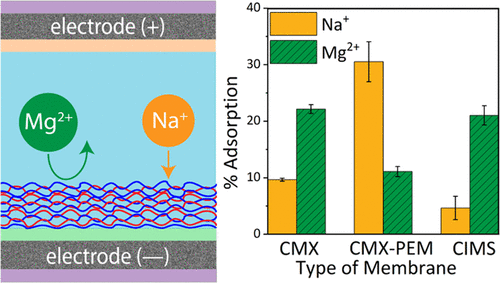当前位置:
X-MOL 学术
›
ACS Appl. Mater. Interfaces
›
论文详情
Our official English website, www.x-mol.net, welcomes your
feedback! (Note: you will need to create a separate account there.)
Modification of Cation-Exchange Membranes with Polyelectrolyte Multilayers to Tune Ion Selectivity in Capacitive Deionization.
ACS Applied Materials & Interfaces ( IF 8.3 ) Pub Date : 2020-06-26 , DOI: 10.1021/acsami.0c05664 Sevil Sahin 1 , Jouke E Dykstra 2 , Han Zuilhof 1, 3, 4 , Rafael L Zornitta 1 , Louis C P M de Smet 1
ACS Applied Materials & Interfaces ( IF 8.3 ) Pub Date : 2020-06-26 , DOI: 10.1021/acsami.0c05664 Sevil Sahin 1 , Jouke E Dykstra 2 , Han Zuilhof 1, 3, 4 , Rafael L Zornitta 1 , Louis C P M de Smet 1
Affiliation

|
Capacitive deionization (CDI) is a desalination technique that can be applied for the separation of target ions from water streams. For instance, mono- and divalent cation selectivities were studied by other research groups in the context of water softening. Another focus is on removing Na+ from recirculated irrigation water (IW) in greenhouses, aiming to maintain nutrients. This is important as an excess of Na+ has toxic effects on plant growth by decreasing the uptake of other nutrients. In this study, we investigated the selective separation of sodium (Na+) and magnesium (Mg2+) in MCDI using a polyelectrolyte multilayer (PEM) on a standard grade cation-exchange membrane (Neosepta, CMX). Alternating layers of poly(allylamine hydrochloride) (PAH) and poly(styrene sulfonate) (PSS) were coated on a CMX membrane (CMX-PEM) using the layer-by-layer (LbL) technique. The layer formation was examined with X-ray photoelectron spectroscopy (XPS) and static water contact angle measurements (SWA) for each layer. For each membrane, i.e., the CMX-PEM membrane, CMX membrane, and for a special-grade cation-exchange membrane (Neosepta, CIMS), the Na+/Mg2+ selectivity was investigated by performing MCDI experiments, and selectivity values of 2.8 ± 0.2, 0.5 ± 0.04, and 0.4 ± 0.1 were found, respectively, over up to 40 cycles. These selectivity values indicate flexible switching from a Mg2+-selective membrane to a Na+-selective membrane by straightforward modification with a PEM. We anticipate that our modular functionalization method may facilitate the further development of ion-selective membranes and electrodes.
中文翻译:

阳离子交换膜与聚电解质多层的修饰,以调节离子去离子性。
电容去离子(CDI)是一种脱盐技术,可用于从水流中分离目标离子。例如,其他研究小组在水软化的背景下研究了单价和二价阳离子选择性。另一个重点是从温室中的循环灌溉水(IW)中去除Na +,以保持营养。这很重要,因为过量的Na +通过减少其他养分的吸收对植物的生长有毒作用。在这项研究中,我们研究了钠(Na +)和镁(Mg 2+)在MCDI中使用标准级阳离子交换膜(Neosepta,CMX)上的聚电解质多层(PEM)。聚(烯丙胺盐酸盐)(PAH)和聚(苯乙烯磺酸盐)(PSS)的交替层使用逐层(LbL)技术涂覆在CMX膜(CMX-PEM)上。通过X射线光电子能谱法(XPS)和每层的静态水接触角测量(SWA)来检查层的形成。对于每种膜,即CMX-PEM膜,CMX膜和特殊等级的阳离子交换膜(Neosepta,CIMS),Na + / Mg 2+通过进行MCDI实验研究了选择性,在多达40个循环中,选择性值分别为2.8±0.2、0.5±0.04和0.4±0.1。这些选择性值表明通过用PEM直接修饰从Mg 2 +-选择性膜到Na +-选择性膜的灵活切换。我们期望我们的模块化功能化方法可以促进离子选择性膜和电极的进一步发展。
更新日期:2020-08-05
中文翻译:

阳离子交换膜与聚电解质多层的修饰,以调节离子去离子性。
电容去离子(CDI)是一种脱盐技术,可用于从水流中分离目标离子。例如,其他研究小组在水软化的背景下研究了单价和二价阳离子选择性。另一个重点是从温室中的循环灌溉水(IW)中去除Na +,以保持营养。这很重要,因为过量的Na +通过减少其他养分的吸收对植物的生长有毒作用。在这项研究中,我们研究了钠(Na +)和镁(Mg 2+)在MCDI中使用标准级阳离子交换膜(Neosepta,CMX)上的聚电解质多层(PEM)。聚(烯丙胺盐酸盐)(PAH)和聚(苯乙烯磺酸盐)(PSS)的交替层使用逐层(LbL)技术涂覆在CMX膜(CMX-PEM)上。通过X射线光电子能谱法(XPS)和每层的静态水接触角测量(SWA)来检查层的形成。对于每种膜,即CMX-PEM膜,CMX膜和特殊等级的阳离子交换膜(Neosepta,CIMS),Na + / Mg 2+通过进行MCDI实验研究了选择性,在多达40个循环中,选择性值分别为2.8±0.2、0.5±0.04和0.4±0.1。这些选择性值表明通过用PEM直接修饰从Mg 2 +-选择性膜到Na +-选择性膜的灵活切换。我们期望我们的模块化功能化方法可以促进离子选择性膜和电极的进一步发展。

































 京公网安备 11010802027423号
京公网安备 11010802027423号